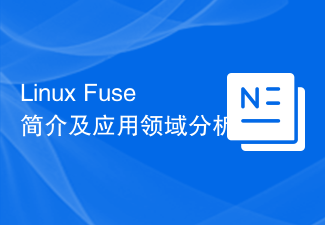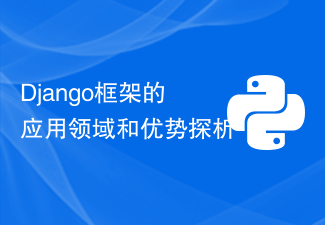
Introduction to Go WaitGroup and its application areas in Golang
Introduction:
Go language (Golang), as an open source statically typed programming language, has been Officially released by Google in 2009. Its goal is to make development easier and more efficient, and is particularly good at handling high concurrency and distributed systems. In Golang, WaitGroup is a very practical concurrency control tool. It allows the main thread to wait for all child threads to complete execution before proceeding to the next step. This article will introduce Go WaitGroup, introduce its application areas in Golang, and give specific code examples.
1. Introduction to Go WaitGroup
Go WaitGroup (waiting group) is a concurrency control tool in Golang. By counting child threads, it realizes the function of continuing execution after the main thread waits for all child threads to complete execution. WaitGroup has three methods: Add(), Done() and Wait().
- Add() method: used to set the number of child threads in the waiting group. Each child thread needs to call the Add() method once before starting execution. This method accepts a positive integer as a parameter, indicating the number of child threads.
- Done() method: used to indicate the end of execution of a child thread. At the last line of code in each child thread, the Done() method needs to be called once. Each time the Done() method is called, the counter in the wait group will be decremented by 1.
- Wait() method: Use this method in the main thread to wait for all sub-threads in the waiting group to complete execution. When the counter in the wait group reaches 0, the main thread continues execution.
2. Application fields of Go WaitGroup
Go WaitGroup is widely used in Golang in scenarios where you need to wait for a set of concurrent tasks to be completed before proceeding to the next step. Several specific application areas will be given below.
- Concurrent crawler
In a crawler program, it is usually necessary to start multiple crawling tasks at the same time to improve efficiency. Using WaitGroup, the main thread can wait for all crawling tasks to be completed before proceeding to the next step. Specific examples are as follows:
func crawl(url string, wg *sync.WaitGroup) {
defer wg.Done()
// 爬取逻辑
}
func main() {
var wg sync.WaitGroup
urls := []string{"url1", "url2", "url3"}
for _, url := range urls {
wg.Add(1)
go crawl(url, &wg)
}
wg.Wait()
// 其他操作
}- Concurrent file processing
During the file processing process, using WaitGroup can make the main thread wait for all file processing tasks to be completed before proceeding to the next step. Specific examples are as follows:
func processFile(file string, wg *sync.WaitGroup) {
defer wg.Done()
// 文件处理逻辑
}
func main() {
var wg sync.WaitGroup
files := []string{"file1", "file2", "file3"}
for _, file := range files {
wg.Add(1)
go processFile(file, &wg)
}
wg.Wait()
// 其他操作
}- Concurrent task execution
In some concurrent task execution scenarios, using WaitGroup can ensure that the main thread waits for all tasks to be executed before proceeding to the next step. Specific examples are as follows:
func executeTask(task func(), wg *sync.WaitGroup) {
defer wg.Done()
task() // 执行任务
}
func main() {
var wg sync.WaitGroup
tasks := []func(){task1, task2, task3}
for _, task := range tasks {
wg.Add(1)
go executeTask(task, &wg)
}
wg.Wait()
// 其他操作
}Summary:
Go WaitGroup is a very practical concurrency control tool in Golang, which is used to implement the function of the main thread waiting for all child threads to complete execution before continuing. WaitGroup can work well in scenarios such as concurrent crawlers, concurrent file processing, and concurrent task execution. We hope that through the introduction and sample code of this article, readers can have a deeper understanding of the use of Go WaitGroup and use it flexibly in actual development.
The above is the detailed content of Introduction to Go WaitGroup and its application areas in Golang. For more information, please follow other related articles on the PHP Chinese website!
 Linux Fuse简介及应用领域分析Mar 16, 2024 pm 12:03 PM
Linux Fuse简介及应用领域分析Mar 16, 2024 pm 12:03 PMLinuxFuse简介及应用领域分析引言在当前的信息技术领域中,Linux操作系统被广泛应用于各种系统和服务中。而LinuxFuse(FilesysteminUserspace)作为一个用户态文件系统框架,为开发者提供了在用户空间实现文件系统的能力,极大地拓展了Linux文件系统的应用范围。本文将深入介绍LinuxFuse框架的基本原理和特点,分析
 Go WaitGroup和Golang并发编程的最佳实践Sep 28, 2023 pm 02:33 PM
Go WaitGroup和Golang并发编程的最佳实践Sep 28, 2023 pm 02:33 PMGoWaitGroup和Golang并发编程的最佳实践摘要:在并发编程中,Go语言的WaitGroup是一个重要的工具。本文将介绍什么是WaitGroup以及如何使用它来管理并发任务,同时还会提供一些实际的代码示例来帮助读者更好地理解并使用WaitGroup。引言:随着计算机硬件的发展,多核处理器已经成为现代计算机的标准配置。为了充分发挥多核处理器的性能优
 Go WaitGroup与消息队列的优雅协作Sep 27, 2023 pm 01:17 PM
Go WaitGroup与消息队列的优雅协作Sep 27, 2023 pm 01:17 PMGoWaitGroup与消息队列的优雅协作,需要具体代码示例在现代的软件开发中,并发编程是一个不可避免的话题。尤其是在处理大规模数据和高并发请求时,有效地管理并发操作是非常重要的。Go语言作为一门强大的并发编程语言,提供了丰富的并发原语来帮助开发者实现高效的并发操作。其中,WaitGroup和消息队列被广泛用于实现异步的协作模式。WaitGroup是Go语
 探索Go语言的多样应用领域:你了解Go可用于哪些项目开发吗?Jan 23, 2024 am 10:01 AM
探索Go语言的多样应用领域:你了解Go可用于哪些项目开发吗?Jan 23, 2024 am 10:01 AMGo语言的应用领域广泛:你知道用Go可以开发哪些项目吗?近年来,Go语言在软件开发领域中备受关注。它以其简洁、高效的特性和语法,逐渐成为开发人员的首选编程语言。除了用于Web开发和服务器编程外,Go语言还可以应用于各种不同的项目。本文将介绍一些常见的Go语言项目,并提供相应的代码示例。网络编程:Go语言的并发模型和高效的网络库使其成为开发网络应用的理想选择。
 性能优化:使用Go WaitGroup降低系统资源消耗Sep 29, 2023 am 11:04 AM
性能优化:使用Go WaitGroup降低系统资源消耗Sep 29, 2023 am 11:04 AM性能优化:使用GoWaitGroup降低系统资源消耗摘要:在大型系统中,并发处理是提高性能的关键。然而,在高并发的情况下,创建大量的goroutine可能会导致系统资源的过度消耗。本文将介绍如何使用Go语言的WaitGroup来管理并限制goroutine的数量,减少系统资源的消耗。一、背景随着互联网的快速发展,我们的应用程序需要同时处理大量的请求。为了提
 计算密集型任务:使用Go WaitGroup优化性能Sep 27, 2023 pm 05:21 PM
计算密集型任务:使用Go WaitGroup优化性能Sep 27, 2023 pm 05:21 PM计算密集型任务:使用GoWaitGroup优化性能概述:在日常的软件开发中,我们经常会遇到计算密集型任务,即需要大量计算和处理的任务,这通常会消耗大量的CPU资源和时间。为了提高性能,我们可以利用Go语言中的WaitGroup来实现并发计算,从而优化任务的执行效率。什么是WaitGroup?WaitGroup是Go语言中的一种机制,它可以用于等待一组协程(
 Django框架的应用领域和优势探析Jan 19, 2024 am 10:43 AM
Django框架的应用领域和优势探析Jan 19, 2024 am 10:43 AMDjango框架的应用领域和优势探析引言:Django是一款使用Python语言开发的Web应用框架,它秉承了"快速开发"的理念,以简单、高效、安全和可扩展性著称。本文将探讨Django框架的应用领域和优势,并给出具体的代码示例。一、应用领域:网站开发Django适用于开发各种规模的网站,无论是小型的个人博客还是大型的企业级网站,Django都能胜任。Dja
 掌握Go语言文档中的sync.WaitGroup函数实现并发控制Nov 03, 2023 pm 08:05 PM
掌握Go语言文档中的sync.WaitGroup函数实现并发控制Nov 03, 2023 pm 08:05 PM掌握Go语言文档中的sync.WaitGroup函数实现并发控制,需要具体代码示例在Go语言中实现并发控制是非常重要的,而sync包中的WaitGroup函数提供了一种简单和有效的方法来实现并发控制。本文将详细介绍如何使用sync.WaitGroup函数,同时提供具体的代码示例。在并发编程中,常常需要等待所有的goroutine完成后才能继续执行后续的代码。


Hot AI Tools

Undresser.AI Undress
AI-powered app for creating realistic nude photos

AI Clothes Remover
Online AI tool for removing clothes from photos.

Undress AI Tool
Undress images for free

Clothoff.io
AI clothes remover

AI Hentai Generator
Generate AI Hentai for free.

Hot Article

Hot Tools

PhpStorm Mac version
The latest (2018.2.1) professional PHP integrated development tool

Atom editor mac version download
The most popular open source editor

SublimeText3 Linux new version
SublimeText3 Linux latest version

ZendStudio 13.5.1 Mac
Powerful PHP integrated development environment

mPDF
mPDF is a PHP library that can generate PDF files from UTF-8 encoded HTML. The original author, Ian Back, wrote mPDF to output PDF files "on the fly" from his website and handle different languages. It is slower than original scripts like HTML2FPDF and produces larger files when using Unicode fonts, but supports CSS styles etc. and has a lot of enhancements. Supports almost all languages, including RTL (Arabic and Hebrew) and CJK (Chinese, Japanese and Korean). Supports nested block-level elements (such as P, DIV),






